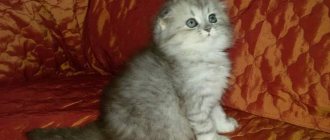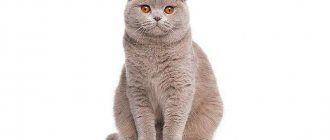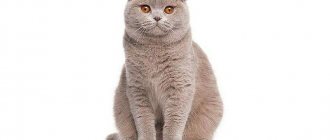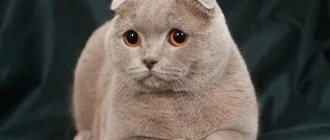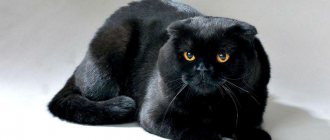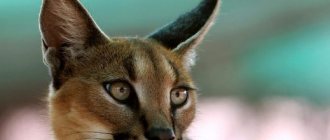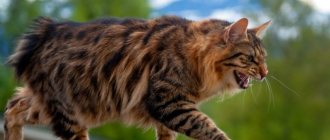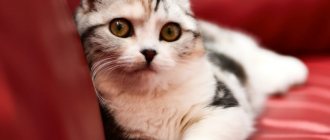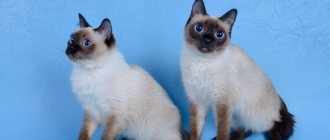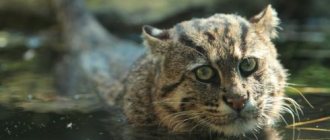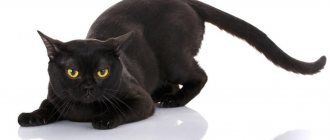Almost all lovers of such pets know the color of color point cats, thanks to the Siamese and Thai breeds. That is why it is quite often confused. But these are not all types of cats that have such an attractive color of their fur. In some distant countries this color may also be called Himalayan. Cats of these breeds are often affectionate and cannot be alone.
Color Description
If translated from English, “color” means color, and “point” means a point. Points are small dark spots located on the face, tail, paws and ears.
The usual color of a cat is solid. The pigment is evenly distributed throughout the animal’s fur and body. Therefore, you can see the uniform color of the pet.
For a color point cat, everything is completely different. Their DNA contains the cs gene, thanks to which the pigment enters only the peripheral parts of the body, that is, the cold ones. They are located at a relative distance from the warm ones. Such areas are the ears, tail, paws and muzzle.
In other parts of the body, where the temperature is relatively higher, the pigment is not able to manifest itself actively. Scientifically this is called acromelanism .
As a result, the pet’s body is painted a lighter color than the rest of the body. The overall color tone remains uniform, but only changes in its saturation and intensity. The more pronounced the border between light and dark coats is, the higher the value of such a cat for exhibition work.
Dark pigmentation can be more than just brown. There are also these colors:
- Black.
- Lilac.
- Smoky.
- Reddish.
- Blue.
Based on this, individual varieties are distinguished, for example, seal point, red point, blue point, etc. Certain breeds can combine several shades at once.
Variations
Colors are divided into three groups: solid, tortoiseshell and tabby. In the first case, the marks have a uniform shade without foreign inclusions. Tortoiseshell implies the presence of heterogeneous spots (a combination of red, brown, blue, cream colors), this type is found only in female animals.
Blue tabby point
Tabby cats have distinct stripes on their fur. There must be a pattern on the forehead resembling the letter M.
Continuous ones include:
- blue – the body has a slightly bluish tint, the markings are gray or blue;
- seal – dark brown markings, cream body fur;
- chocolate or choklit - spots of rich milk chocolate color, body color - white or slightly creamy;
- cream – soft cream, body slightly lighter than the spots;
- red – the spots have a red (rich red) color, the body is cream or light apricot;
- lilac – the fur on the body is white, the markings are purple;
- cinnamon – cinnamon-colored spots, beige body;
- faun - the fur on the body is beige (almost white), the spots are light purple.
Tonkinese fawn point kitten
Tortoiseshells include (the first word in the name is the main color of the spots, the second word is the color of the inclusions):
- blue cream;
- seal-cake;
- Lilac cake;
- Chokli-torty.
Tortoiseshell British cat
There are various variations among tabbies. The word tabby must be added to the name.
Features of color
The color point cat breed is no longer some kind of exotic. Every year such pets are becoming increasingly popular. But they still have certain features:
- Color point kittens are always born only in light shades. Only after a few days do the first pigment spots begin to appear on the paws, tail, and then on the face. This is due to the fact that during intrauterine development the kittens were exposed to constant warm temperatures. After birth and exposure to a colder environment, the coloring pigment begins to activate, which entails darkening of certain areas of the body.
- The appearance of a point kitten can only be guaranteed if both of its parents also have a pigmented color. But sometimes there are exceptions. One or even both parents can have a solid coat, but be carriers of the cs gene, which is responsible for darkening the peripheral areas of the body. In this case, some kittens will turn out to be pointing.
- The intensity of the color difference depends on the temperature in which the animal is located. The lower it is, the darker and richer the pigment areas will be.
- The cs gene is directly related to the color of the pet's eyes, which must be blue. In this case, the breed does not matter. The brighter and more saturated the color, the better the color of the animal appears.
It must be remembered that cats kept in cool conditions may completely lose their unique color. The ideal temperature for such breeds is from +25 degrees Celsius.
What does genetics have to do with it?
Many people are probably wondering: how did it happen that all the representatives of this group are colored so uniquely? To answer this question, you will have to go back many decades and remember that cats became the object of attention of specialists in the second half of the 19th century. The British then began to perceive them as purebred animals and specially breed certain species.
The color point color is found in cats such as Ragamuffin, Highland Fold, Balinese, Siberian and American Shorthair.
The Siamese and Persian cats marked the beginning of the official registration of cat breeds. Later they became the progenitors of many modern cat breeds, including color points. Siamese cats came to Europe in 1870 and became favorites of many families. Blue eyes and unusual coloring are what attracted me in the first place.
Some scientific facts.
The color of the coat and eyes depends on a polymer pigment called melanin. It is formed from the amino acid tyrosine under the influence of the enzyme tyrosinase. It is this enzyme that is controlled by the gene that determines color, which is called Color. This gene is designated by the letter “C”. When the C gene is mutated, no active tyrosinase is produced and the pigment does not appear. In this case, the cat is born an albino, that is, uncolored. And the mutated gene is already indicated by the small letter “c”.
Where did these black spots come from then?
Scientists have discovered the Himalayan gene cs, or ch, which is also formed from a mutated gene C. But in this case, the enzyme tyrosinase becomes heat-sensitive, that is, depending on the temperature, it changes its activity: at high temperatures, tyrosinase is inactive, and as soon as the temperature drops, melanin in the cells, fur begins to be produced and dyes the cooled areas in darker colors. This is how the Siamese color turns out, which, by the way, is found not only in cats. In the last 30–40 years, geneticists have developed a large number of breeds that differ in color point color.
Main breeds
Thai and Siamese cat breeds are precisely those that have the color point pigment initially. This is implied by the standard. But there are other types. In addition to plain coats, they also have point subspecies. These include:
- Persian. This is the first breed that has been successfully turned into a pointing breed, with the exception of the Siamese. The Point Persian was created by mating a Siamese cat with an ordinary Persian cat. But there is also a small minus for the owners - a lot of attention must be paid to the luxurious fur of these pets.
- British colorpoint cats. This is a separate subspecies of ordinary Britons, which was first bred not so long ago. Breeding them is quite a difficult task, so babies of this breed are highly valued.
- Scottish straight. Representatives of this breed have darkened areas that look like a light haze. It was possible to breed by mating the best specimens of the British and Persians. These are very beautiful cats, and they also have a soft and flexible character.
- Neva Masquerade. These are Siberian cats with pigment coloring. They were first bred by St. Petersburg breeders by crossing Siberians and Siamese. The artificially bred breed is extremely beautiful. Its representatives have a rather large body with a very thick coat, which was inherited from their Siberian ancestors. It goes well with the colors of the Siamese, as well as the deep blue eyes.
- This coloring is found in all breeds of sphinxes, for example, Canadian or Peterbalds. They have point coloring on their skin, since the fur is completely or almost completely absent.
This is not the entire list of breeds with this coat color. There are also very rare ones, for example, snowshoe or Burmese. But they are not yet very common in the world.
Scottish Highland Straight
The Scottish Highland Straight is a subspecies of the Scottish cat. It is distinguished by the fact that it has long hair and erect ears. This variety has an unusual color. They brought her out in the 70s. years of the last century, when the British crossed with the Persians. Kittens from these breeds were able to get only the best. They have a very calm and friendly character, as well as a cute appearance. Highland Straights are easy to maintain. There is also a tortoiseshell variety, which also has a point color. Description of the breed:
- Quite long coat that is very easy to comb. Has a relatively dense undercoat.
- The ears are small in size with rounded tips and stand erect.
- The eyes are large and round in shape. Color may vary. He is completely dependent on wool.
- The body is strong, muscular, of medium size. Often these cats have a round shape.
- The toes are quite tightly clenched. The limbs themselves are long.
- The head is round and has a convex skull.
- Average tail length. He is very fluffy and active.
- These cats live from 10 to 20 years.
- The average weight of animals is 3.5 kg, and that of a cat is 5 kg.
- Standard length is 30 cm.
This breed is very flexible. But their main advantage is their tenderness and friendliness. When buying a kitten, you should pay attention to the color, as there should not be white color.
If it is present, then such a pet will not be able to participate in exhibitions.
British Shorthair
There is a well-established opinion that this breed was brought to Great Britain in the first century BC by the Romans. The main advantage at that time was considered to be short and very thick wool. It helped protect cats from excessive moisture, as well as small parasites while hunting rodents. The British breed was very hardy and had good health. They were used as hunters. Only many centuries later they began to be looked at from the point of view of beauty. The first exhibition took place in 1871. Description of the breed:
- The British Shorthair cat has a thick and dense coat. The color may be completely different.
- The eyes are large and round in shape. Very often a red tint appears.
- The ears are small and straight, set low.
- The body is of medium size. Cats are usually strong and slender.
- The legs are straight and short.
- Massive round head.
- The neck is powerful and thick.
- The tail is fleshy. Has a rounded end.
- The standard weight for a female is 4 kg, for a male - 6 kg.
- These cats usually live 10-15 years.
The British breed can only be long-haired or short-haired.
A long coat is standard for this species. The short one appeared thanks to the mating of a Briton and a Persian. Many experts argue that the differences are only noticeable in the length of the coat. Although sometimes changes in the chin may also appear.
Compared to the Scots, the British are distinguished by their independence. They may very often do things contrary to instructions. This breed easily tolerates loneliness, but still has a kind and affectionate disposition. Quite often, the British are wary of strangers and do not allow them to touch them.
Appearance
Today, color point cats differ significantly from those that were obtained as a result of the first experiments. The structure of their coat and body structure are very similar to Persians.
The body is squat, muscular, with a broad, massive chest and well-developed shoulders. The limbs are squat and stable. The tail is of medium length and unusually fluffy.
On a round, proportional head, under long hair, small ears with rounded tips are almost invisible. They are located quite low and widely spaced. The round cheeks and developed chin are clearly visible on the muzzle.
Large, round, very expressive eyes are set widely apart and most often have a bright blue color.
Luxurious wool is another distinctive feature of this breed. Its length can reach up to 12 cm. The wool is very thick, thin, and has a silky structure. It forms a chic collar on the neck and chest.
The color of the breed is determined by the color of the spots. The most popular is with brown, almost black, markings. At the same time, the general background is light, almost white. There are cats with blue and lilac markings.
We suggest you read: Cat bite - What to do if bitten by a cat, first aid and treatment methods
Depending on their color, all representatives of the breed are divided according to color into groups called:
- Blue Point
- Chocolate point
- Lilac Point
Character of color point
The character of the color point is always very cheerful . These cats are quite energetic and have taken all the best habits from their Siamese ancestors. In some cases, they are jealous of their owners, and may also be offended that they are given too little attention. But still, cats are not at all aggressive and make excellent contact not only with people, but also with other animals that are in the apartment.
They are also distinguished by a certain obstinacy. It is better not to offend such a breed, because cats will remember everything in the future. But when a pet is surrounded by love and care, it will be a very loyal friend.
This breed will appeal to those who rarely leave their cozy apartment for a long time. Colorpoint cats need constant attention from their owner. They want to be involved in a person's life. Pets will be happy to crawl under the blanket or jump on your lap and wait to be petted. The cat will immediately begin to purr contentedly.
Origin story
In the early 30s of the last century, the famous American breeder from Boston decided to breed a variety of Persian cat with a Siamese color.
The work continued for quite a long time and only in 1936 the first kitten appeared that met all the requirements of the experiment. Over the next few years, the breed was improved in order to consolidate the Siamese color and Persian face.
In 1955, it was officially recognized by the felinological organization GCCF. Later, in the mid-seventies, these cats were classified as part of the Persian group.
Maintenance and care
Almost all breeds with this color are more valuable when the contrast between the base color and the pigment parts is strong. Therefore, the main task of a person is to maintain the correct color. In addition to temperature, other factors also affect color.
The first one is age. Almost every cat darkens over time . The pet’s diet can also greatly affect the color. An indisputable fact is that carrots and seaweed, which contain a lot of iodine, can change the color of an animal. You should be careful about the composition of the feed. It is not advisable to give your cat vitamins that contain seaweed and kelp. You should not feed foods containing a lot of copper.
Experts have noticed that Thais begin to quickly turn dark when eating beef, any seafood, liver and buckwheat. If there is a predisposition, then the best solution would be to use special feed.
Any damage can also change the color of fur and even skin. In areas where injury or surgery has been performed, the fur will be much darker. This is due to the fact that that area of the body will become much colder. In some cases, color may return after the first molt, but this does not always happen.
If you definitely need to have surgery, then it is advisable to choose a place that will be least noticeable. After the procedure, it is necessary to carefully wrap the incision until complete healing.
We must not forget about trimming the claws. This should be done so that the pet cannot hurt itself.
Tabby
Pronounced spots appearing against a contrasting background form a tabby or tabby color. Typically, spots or stripes are visible on the face, ears, around the neck, paws and tail. On the frontal part of the animals, the silhouette of the letter M is clearly visible.
Felinologists distinguish several types of tabbbing:
- shaded or marble;
- spotted or spotted;
- mackerel or tiger.
Marble on silver
The merle color is characterized by the presence of butterfly-shaped spots on the cat's shoulders. The back is divided by three large stripes, and there are many small spots on the fluffy belly. Kittens with gold or silver marble are especially prized.
Spotted Scottish cats have one stripe running along the spine. The sides are covered with round and oval spots. Tiger folds are distinguished by stripes throughout the body.
Ticked
Ticked Scots look the most impressive. The term ticking refers to the alternation of three-color colors on each fiber. The presence of layer-by-layer coloring in the fur gives the animal a unique appearance. Typically, when ticking there is a transition from yellow to black or brown tones.
Owner reviews
I could never imagine my life without some animals. I always considered everyone I had as part of the family. The cat was bought about 5 years ago. He was about a month old then. He didn’t even know how to feed himself or go to the toilet yet. Most likely, the seller needed to sell the cat as quickly as possible, so he lied a little about the baby’s readiness for independent life. In general, the kitten was named Bonya.
Color point cats are very cute and gentle kittens, and adult cats too. They are quite interesting to watch. They are funny, active and cheerful.
Zhenya
We bought a British Shorthair as an adult. At that time she was 10 months old. She is very clingy by nature and loves a lot of human attention. She herself jumps into her arms, but only in those cases when she exactly wants it. You can squeeze for hours, the cat is very patient.
Lilya
We have a Sphynx Peterbald cat. They set up a special place for her to sleep, but she only sleeps there during the day. At night he always comes to my bed.
The character is quite capricious.
She hates being alone. When this happens, he immediately starts screaming. You can't just pick it up and play. You'll have to wait until she wants to. If she doesn't like something, she may even throw herself. She was scratched and bitten several times. Catherine
How to choose a kitten
It is very difficult to determine the color of a Siberian color point. A kitten that is completely white from birth, living in different conditions, may have a different final color. This is due to a temperature-sensitive gene. A cat reaches its final formation by the age of four to five years, which makes it difficult to predict the animal’s show class (exhibition class).
When deciding to get a Siberian Color Point, you should decide on the purpose: breeding, exhibitions or a pet. But, regardless of it, it is better to buy a kitten in special nurseries that breed the breed. It is not recommended to take a kitten from its mother before 2-3 months of age. Upon reaching this age, kittens acquire all the necessary skills and become more independent.
The price of a kitten from breeders is from 20,000 rubles and above. You can find out the cost in Moscow and St. Petersburg by following the links below to 8 popular nurseries.
Breeding and show class animals are difficult to identify at a young age. It’s better not to rush and turn to experienced felinologists. The future winner will have to be raised with patience and following the strict recommendations of the breeder. The kitten must learn to “show itself”, get used to examinations by experts and transportation in transport.
Breeders recommend choosing a pet class pet not from photographs, but directly from the nursery. Often, having chosen a kitten by color, future owners do not find a common language with this particular representative of the breed, but leave with other, no less worthy representatives of the breed.
When choosing a companion, it is necessary to evaluate in what conditions and atmosphere the animals are in the nursery. You can try to find contact with the parents of the future pet; it is possible that the character was inherited. It is better to pick up a kitten from the nursery after full vaccination.
